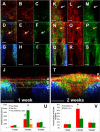Scaffolds for tendon and ligament repair and regeneration
- PMID: 25650098
- PMCID: PMC4380768
- DOI: 10.1007/s10439-015-1263-1
Scaffolds for tendon and ligament repair and regeneration
Abstract
Enhanced tendon and ligament repair would have a major impact on orthopedic surgery outcomes, resulting in reduced repair failures and repeat surgeries, more rapid return to function, and reduced health care costs. Scaffolds have been used for mechanical and biologic reinforcement of repair and regeneration with mixed results. This review summarizes efforts made using biologic and synthetic scaffolds using rotator cuff and ACL as examples of clinical applications, discusses recent advances that have shown promising clinical outcomes, and provides insight into future therapy.
Figures





References
-
- Aurora A, Mccarron JA, Van Den Bogert AJ, Gatica JE, Iannotti JP, Derwin KA. The biomechanical role of scaffolds in augmented rotator cuff tendon repairs. J Shoulder Elbow Surg. 2012;21:1064–1071. - PubMed
-
- Barber FA, Burns JP, Deutsch A, Labbe MR, Litchfield RB. A prospective, randomized evaluation of acellular human dermal matrix augmentation for arthroscopic rotator cuff repair. Arthroscopy. 2012;28:8–15. - PubMed
-
- Beimers L, Lam PH, Murrell GA. The biomechanical effects of polytetrafluoroethylene suture augmentations in lateral-row rotator cuff repairs in an ovine model. J Shoulder Elbow Surg. 2014;23:1545–1552. - PubMed
-
- Bishop J, Klepps S, Lo IK, Bird J, Gladstone JN, Flatow EL. Cuff integrity after arthroscopic versus open rotator cuff repair: a prospective study. J Shoulder Elbow Surg. 2006;15:290–299. - PubMed
Publication types
MeSH terms
Grants and funding
- R01 AR052743/AR/NIAMS NIH HHS/United States
- R01 AR052374/AR/NIAMS NIH HHS/United States
- AR052743/AR/NIAMS NIH HHS/United States
- AR052374/AR/NIAMS NIH HHS/United States
- R01 AG039561/AG/NIA NIH HHS/United States
- R44AR060032/AR/NIAMS NIH HHS/United States
- AR056943/AR/NIAMS NIH HHS/United States
- R01 AR054713/AR/NIAMS NIH HHS/United States
- R01 AR056943/AR/NIAMS NIH HHS/United States
- T90 DE021989/DE/NIDCR NIH HHS/United States
- R44 AR060032/AR/NIAMS NIH HHS/United States
- AG039561/AG/NIA NIH HHS/United States
- DE021989/DE/NIDCR NIH HHS/United States
- AR54713/AR/NIAMS NIH HHS/United States
LinkOut - more resources
Full Text Sources
Other Literature Sources

